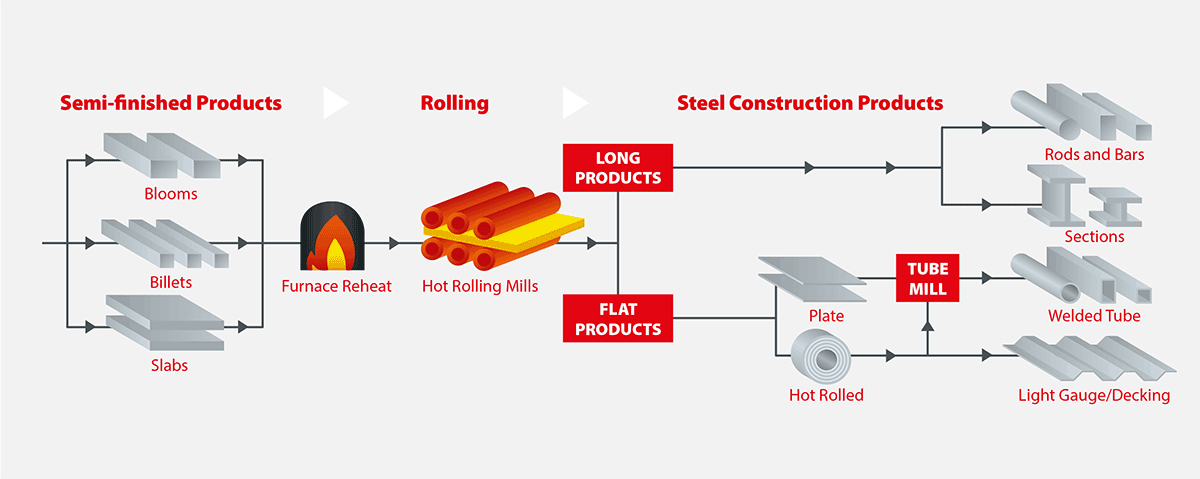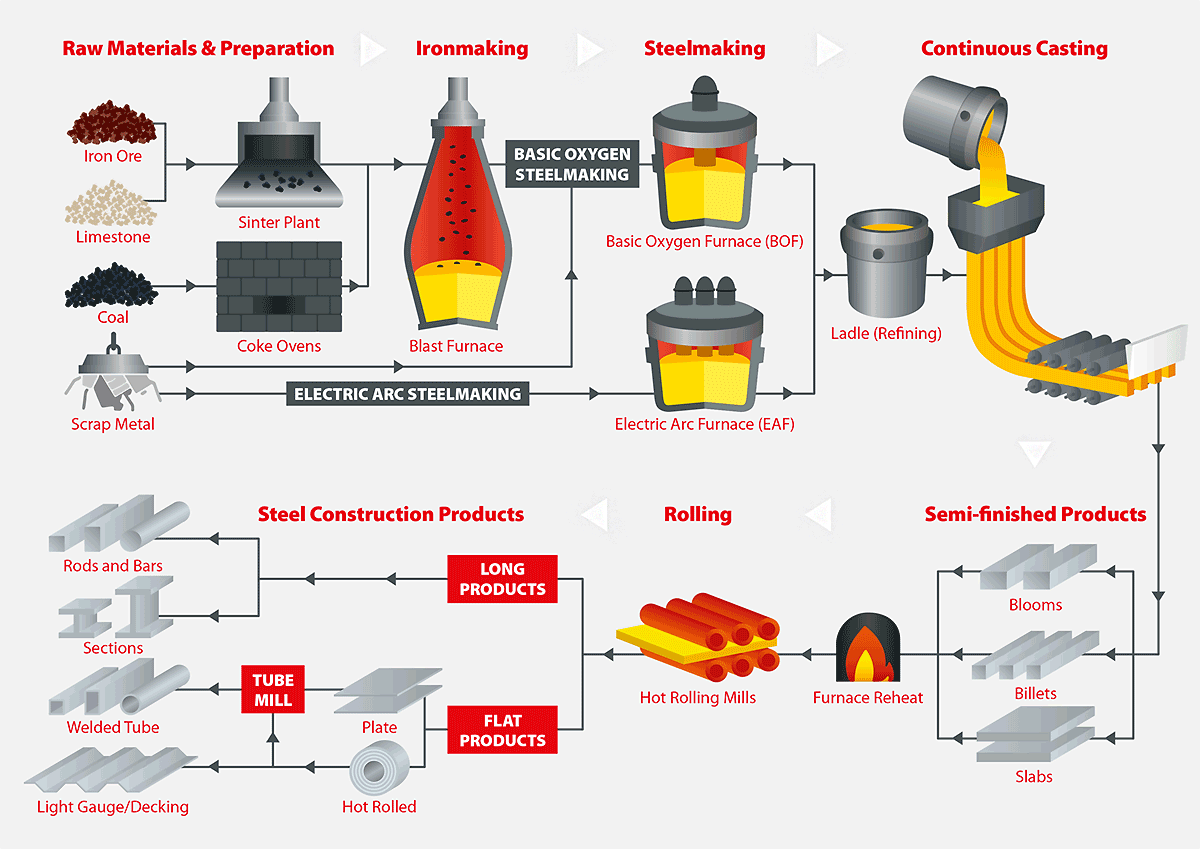Projects and Features
An introduction to steel construction products
In this sector focus article, New Steel Construction provides an overview of the various forms of steel construction products and describes how they are produced.
Semi-finished billets, blooms and slabs from the continuous casting process (see NSC Sept 2017) are transformed into a variety of construction products by various processes of heating and mechanical working. The resulting products are either used directly in the fabrication of steel components, that are subsequently assembled into structures on site, or made into further products for use in construction.

Shaping Steel
Steel is a strong material that is highly resistant to shaping at normal temperatures, but this resistance lessens considerably at higher temperatures. For that reason, the billets, blooms and slabs from the steelmaking process are shaped into basic products at carefully controlled elevated temperatures.
The method that is most commonly used for shaping is to heat the steel to around 1280°C in a reheat furnace and then roll the steel, squeezing it between sets of rolls. Rolls are arranged in pairs, either just horizontally or both horizontally and vertically, and housed in a ‘stand’.
To change the shape of a material as strong as steel the rolls must exert forces measured in hundreds of tonnes and must also draw the steel continuously through the rolls while reducing the thickness. Two main classes of product are produced – flat products such as plates, sheets or strips of uniform thickness, and long products which are lengths of a particular cross section, ranging from rectangular bars to double flange H sections.
“We pride ourselves on the quality of our products and services, and our ability to respond to customer requirements.
“Our steel is produced to the highest standards – well within the tightest dimensional tolerances – and we’ve a proven track record of delivering cost-effective solutions for developments of all sizes, from skyscrapers and sports stadia to schools and shopping centres.
“We continue to invest in our manufacturing operations to further improve the quality of our steel, and we also have an established network of distribution centres across the UK and Ireland. In doing so, we’re not only able to offer a first class service but offer great value in the UK steel construction supply chain.”
British Steel Managing Director Construction, Richard FarnsworthFor flat products, two horizontal rolls are set one above the other in an open housing. These work rolls that contact the hot steel are often supported by larger diameter rolls to prevent them bending under the rolling loads to ensure a uniform thickness product.
For long products there are two types of mills; structural and universal. In a structural mill there are multiple stands each containing specially shaped rolls where the full set of rolls gradually shape the hot steel in successive passes through separate roll gaps. The product passes through each roll gap only once. In a universal mill the stands contain both vertical and horizontal rolls and the hot steel passes backwards and forwards through the same mill multiple times with the shape being formed by reducing the gap between rolls on successive passes.
Plates
Plates are available in a wide range of grades and sizes. For use in building construction plate will normally be welded into fabricated sections.
Normal plate sizes range from 5mm to 200mm thick, with widths up to 3.5m and lengths up to 18.0m. Plates with a nominal yield strength of 275N/mm² or 355N/mm², commonly used in construction, can be supplied in either the As Rolled (AR), Normalised (N), Normalised Rolled (NR) or Thermomechanically Rolled (TM) supply conditions, and are rolled from continuously-cast slab.
Close control of chemical composition is maintained to produce clean steels with consistent strength and toughness properties that meet all relevant national standards, as with all structural products, and state-of-the-art levellers produce flat plates with controlled residual stress.
Strip
Strip steel is used to produce many different products and in many applications. It is available in three main forms.
- Hot rolled
- Cold rolled
- Hot-dipped galvanized coil.
The most common form of strip steel used in construction is hot-dip galvanized coil. The typical thickness used in construction is 0.4 to 3.2mm. It is generally available in coiled form in widths from 900 to 1,800mm.
Standard open sections
Open sections commonly used in construction range from large columns, beams and piles down to smaller products including channels and angles.
Various types of mill are used to produce different long products. For example, heavy section and medium section mills have three or four stands using rolls with specially machined profiles corresponding to the initial roughing, and the intermediate and finishing stages of rolling.
British, European and International standards define dimensions for a wide variety of open section shapes, such as I and H shaped sections, angles and channels.
“Shortly customers will be able to benefit from ArcelorMittal Section’s continued investment in quality and service; in 2017 we started a €40 million programme of upgrading the finishing facilities at our Differdange mill which includes the world’s largest section roller straightener with a 2500cm³ modulus.”
ArcelorMittal Senior Technical Sales Engineer & Business Development, Neil TilleyThe nominal sizes of ‘universal beams’ (UB), ‘universal columns’ (UC) and ‘parallel flange channels’ (PFC) are given in BS EN 10365, which replaced the old BS4 in February 2017. These sections are typically defined by a serial size (nominal flange width and section depth) and a weight per metre created by varying the thickness of the web and flanges. (Note that the ‘internal’ width between flanges is constant for any serial size – it is determined by the rolls – and an increase in flange thickness results in a corresponding increase in depth.) Dimensions for design, detailing and resistance are given in the Steel for Life Interactive Blue Book and the ArcelorMittal Orange Book.
The nominal sizes of ‘angles’ are given in BS EN 10056 and these sections are typically defined by a serial size comprising the leg length, either equal or unequal, and the leg thickness.
Hot rolled open sections are produced in lengths up to about 25m. A nominal yield strength of 355N/mm² is most commonly used in construction, although 460N/mm² sections are also available. Such sections are typically supplied in either the As Rolled (AR) or Thermomechanically Rolled (TM) supply conditions, and are rolled from continuously-cast blooms, billets or ‘dog bones’.
Structural hollow sections
There are two basic methods of producing hollow sections – the seamless process in which a hole is pierced through a hot solid bar to form the bore and then the bar is rolled to form the round tube, and the welded process in which a steel plate or strip is formed into a cylindrical shape and the edges welded together. The latter is the most commonly employed for structural applications. The High Frequency Electric Resistance Welding (HFERW) method forms the bulk of tube production in small and medium sizes, up to 508mm in diameter. Steel strip is uncoiled and guided, cold, through sets of forming rolls to produce the cylindrical shape. At the point where the edges meet, a high frequency current is introduced into the edges of the strip, either by induction using an encircling coil or by contacts sliding on the surface of the strip. The electric current produces enough local heat to melt the strip edges as they are forged together. The weld is formed instantly. Pipes of wall thicknesses above 16mm and with diameters above 508mm are produced by several consecutive forming processes and Submerged Arc Welded (SAW).
Square and Rectangular hollow sections are ‘squared up’ by passing them through a suitable series of work rolls that progressively changes the shape. This reduction and reshaping process can be carried out hot or cold, which results in the distinction between ‘hot finished’ and ‘cold formed’ products. For a cold formed rectangular section, the corner radius is not as tight as can be achieved with the hot process (which makes it easy to distinguish the two types visibly). The mechanical properties of hot finished and cold formed can also vary and for this reason it is unwise to consider these products as interchangeable.
Hollow sections are typically produced in lengths 6m to 14.5m, depending on the size and thickness, and these sections are typically defined by a serial size comprising the outer dimension(s), and the wall thickness. Dimensions for hollow sections are defined in BS EN 10210-2 for hot finished sections and BS EN 10219-2 for cold formed sections. A nominal yield strength of 355N/mm² is most commonly used in construction, although 420N/mm² hot finished hollow sections are also available.
 Sponsors
Sponsors
Steelmaking
Headline: ArcelorMittal, British Steel
Silver: Tata Steel












